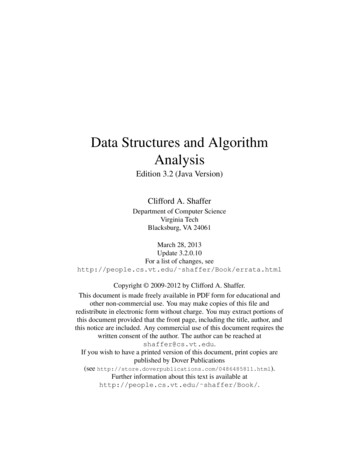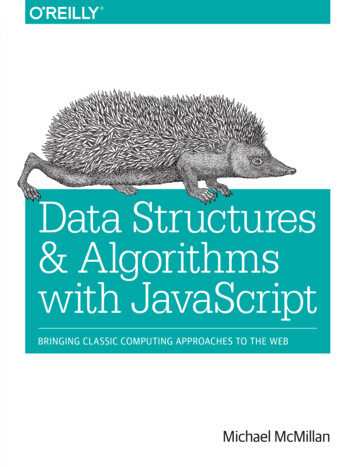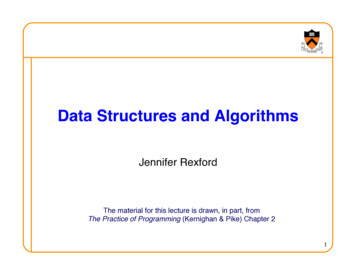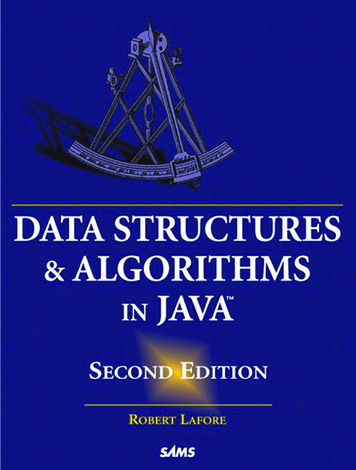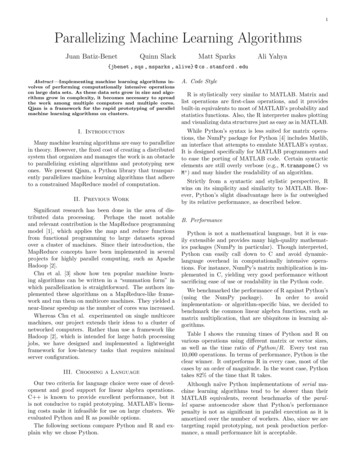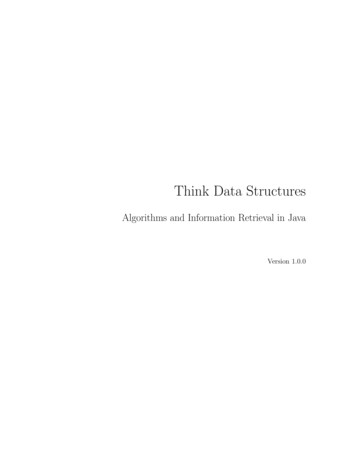
Transcription
Think Data StructuresAlgorithms and Information Retrieval in JavaVersion 1.0.0
Think Data StructuresAlgorithms and Information Retrieval in JavaVersion 1.0.0Allen B. DowneyGreen Tea PressNeedham, Massachusetts
Copyright 2016 Allen B. Downey.Green Tea Press9 Washburn AveNeedham, MA 02492Permission is granted to copy, distribute, and/or modify this work under theterms of the Creative Commons Attribution-NonCommercial-ShareAlike 3.0Unported License, which is available at http://thinkdast.com/cc30.The original form of this book is LATEX source code. Compiling this code hasthe effect of generating a device-independent representation of the book, whichcan be converted to other formats and printed.The LATEX source for this book is available from http://thinkdast.com/repo.
ContentsPreface0.1xiPrerequisites . . . . . . . . . . . . . . . . . . . . . . . . . . .1 Interfacesxii11.1Why are there two kinds of List? . . . . . . . . . . . . . . .21.2Interfaces in Java . . . . . . . . . . . . . . . . . . . . . . . .21.3The List interface . . . . . . . . . . . . . . . . . . . . . . . .31.4Exercise 1 . . . . . . . . . . . . . . . . . . . . . . . . . . . .52 Analysis of Algorithms92.1Selection sort . . . . . . . . . . . . . . . . . . . . . . . . . .102.2Big O notation . . . . . . . . . . . . . . . . . . . . . . . . .132.3Exercise 2 . . . . . . . . . . . . . . . . . . . . . . . . . . . .143 ArrayList193.1Classifying MyArrayList methods . . . . . . . . . . . . . . .193.2Classifying add . . . . . . . . . . . . . . . . . . . . . . . . .213.3Problem Size . . . . . . . . . . . . . . . . . . . . . . . . . . .243.4Linked Data Structures . . . . . . . . . . . . . . . . . . . . .243.5Exercise 3 . . . . . . . . . . . . . . . . . . . . . . . . . . . .27
viCONTENTS3.6A note on garbage collection . . . . . . . . . . . . . . . . . .4 LinkedList30314.1Classifying MyLinkedList methods . . . . . . . . . . . . . .314.2Comparing MyArrayList and MyLinkedList . . . . . . . . .344.3Profiling . . . . . . . . . . . . . . . . . . . . . . . . . . . . .354.4Interpreting results . . . . . . . . . . . . . . . . . . . . . . .374.5Exercise 4 . . . . . . . . . . . . . . . . . . . . . . . . . . . .395 Doubly-linked list415.1Performance profiling results . . . . . . . . . . . . . . . . . .415.2Profiling LinkedList methods . . . . . . . . . . . . . . . . .435.3Adding to the end of a LinkedList . . . . . . . . . . . . . .445.4Doubly-linked list . . . . . . . . . . . . . . . . . . . . . . . .475.5Choosing a Structure . . . . . . . . . . . . . . . . . . . . . .486 Tree traversal516.1Search engines . . . . . . . . . . . . . . . . . . . . . . . . . .516.2Parsing HTML . . . . . . . . . . . . . . . . . . . . . . . . .526.3Using jsoup . . . . . . . . . . . . . . . . . . . . . . . . . . .546.4Iterating through the DOM . . . . . . . . . . . . . . . . . .566.5Depth-first search . . . . . . . . . . . . . . . . . . . . . . . .576.6Stacks in Java . . . . . . . . . . . . . . . . . . . . . . . . . .586.7Iterative DFS . . . . . . . . . . . . . . . . . . . . . . . . . .597 Getting to Philosophy617.1Getting started . . . . . . . . . . . . . . . . . . . . . . . . .617.2Iterables and Iterators . . . . . . . . . . . . . . . . . . . . .62
CONTENTSvii7.3WikiFetcher . . . . . . . . . . . . . . . . . . . . . . . . . .647.4Exercise 5 . . . . . . . . . . . . . . . . . . . . . . . . . . . .668 Indexer698.1Data structure selection. . . . . . . . . . . . . . . . . . . .698.2TermCounter . . . . . . . . . . . . . . . . . . . . . . . . . .718.3Exercise 6 . . . . . . . . . . . . . . . . . . . . . . . . . . . .749 The Map interface799.1Implementing MyLinearMap . . . . . . . . . . . . . . . . . .799.2Exercise 7 . . . . . . . . . . . . . . . . . . . . . . . . . . . .809.3Analyzing MyLinearMap . . . . . . . . . . . . . . . . . . . .8110 Hashing8510.1Hashing . . . . . . . . . . . . . . . . . . . . . . . . . . . . .8510.2How does hashing work? . . . . . . . . . . . . . . . . . . . .8710.3Hashing and mutation . . . . . . . . . . . . . . . . . . . . .8910.4Exercise 8 . . . . . . . . . . . . . . . . . . . . . . . . . . . .9111 HashMap9311.1Exercise 9 . . . . . . . . . . . . . . . . . . . . . . . . . . . .9311.2Analyzing MyHashMap . . . . . . . . . . . . . . . . . . . . . .9511.3The tradeoffs . . . . . . . . . . . . . . . . . . . . . . . . . .9611.4Profiling MyHashMap . . . . . . . . . . . . . . . . . . . . . . .9711.5Fixing MyHashMap . . . . . . . . . . . . . . . . . . . . . . . .9811.6UML class diagrams12 TreeMap. . . . . . . . . . . . . . . . . . . . . .100103
viiiCONTENTS12.1What’s wrong with hashing? . . . . . . . . . . . . . . . . . .10312.2Binary search tree . . . . . . . . . . . . . . . . . . . . . . . .10412.3Exercise 10 . . . . . . . . . . . . . . . . . . . . . . . . . . . .10612.4Implementing a TreeMap . . . . . . . . . . . . . . . . . . . .10813 Binary search tree11113.1A simple MyTreeMap . . . . . . . . . . . . . . . . . . . . . .11113.2Searching for values . . . . . . . . . . . . . . . . . . . . . . .11213.3Implementing put . . . . . . . . . . . . . . . . . . . . . . . .11413.4In-order traversal . . . . . . . . . . . . . . . . . . . . . . . .11613.5The logarithmic methods . . . . . . . . . . . . . . . . . . . .11713.6Self-balancing trees . . . . . . . . . . . . . . . . . . . . . . .11913.7One more exercise . . . . . . . . . . . . . . . . . . . . . . . .12014 Persistence12114.1Redis . . . . . . . . . . . . . . . . . . . . . . . . . . . . . . .12214.2Redis clients and servers . . . . . . . . . . . . . . . . . . . .12314.3Making a Redis-backed index. . . . . . . . . . . . . . . . .12414.4Redis data types. . . . . . . . . . . . . . . . . . . . . . . .12614.5Exercise 11 . . . . . . . . . . . . . . . . . . . . . . . . . . . .12814.6More suggestions if you want them . . . . . . . . . . . . . .13014.7A few design hints . . . . . . . . . . . . . . . . . . . . . . . .13115 Crawling Wikipedia13315.1The Redis-backed indexer . . . . . . . . . . . . . . . . . . .13315.2Analysis of lookup . . . . . . . . . . . . . . . . . . . . . . . .13615.3Analysis of indexing . . . . . . . . . . . . . . . . . . . . . . .137
CONTENTSix15.4Graph traversal . . . . . . . . . . . . . . . . . . . . . . . . .13815.5Exercise 12 . . . . . . . . . . . . . . . . . . . . . . . . . . . .13916 Boolean search14316.1Crawler solution . . . . . . . . . . . . . . . . . . . . . . . . .14316.2Information retrieval . . . . . . . . . . . . . . . . . . . . . .14616.3Boolean search. . . . . . . . . . . . . . . . . . . . . . . . .14616.4Exercise 13 . . . . . . . . . . . . . . . . . . . . . . . . . . . .14716.5Comparable and Comparator . . . . . . . . . . . . . . . . . .15016.6Extensions . . . . . . . . . . . . . . . . . . . . . . . . . . . .15217 Sorting15517.1Insertion sort . . . . . . . . . . . . . . . . . . . . . . . . . .15617.2Exercise 14 . . . . . . . . . . . . . . . . . . . . . . . . . . . .15817.3Analysis of merge sort . . . . . . . . . . . . . . . . . . . . .15917.4Radix sort . . . . . . . . . . . . . . . . . . . . . . . . . . . .16217.5Heap sort . . . . . . . . . . . . . . . . . . . . . . . . . . . .16317.6Bounded heap . . . . . . . . . . . . . . . . . . . . . . . . . .16517.7Space complexity . . . . . . . . . . . . . . . . . . . . . . . .166Index169
xCONTENTS
PrefaceThe philosophy behind the bookData structures and algorithms are among the most important inventions ofthe last 50 years, and they are fundamental tools software engineers need toknow. But in my opinion, most of the books on these topics are too theoretical,too big, and too “bottom up”:Too theoretical Mathematical analysis of algorithms is based on simplifyingassumptions that limit its usefulness in practice. Many presentations ofthis topic gloss over the simplifications and focus on the math. In thisbook I present the most practical subset of this material and omit orde-emphasize the rest.Too big Most books on these topics are at least 500 pages, and some aremore than 1000. By focusing on the topics I think are most useful forsoftware engineers, I kept this book under 200 pages.Too “bottom up” Many data structures books focus on how data structures work (the implementations), with less about how to use them (theinterfaces). In this book, I go “top down”, starting with the interfaces.Readers learn to use the structures in the Java Collections Frameworkbefore getting into the details of how they work.Finally, some books present this material out of context and without motivation: it’s just one damn data structure after another! I try to liven it up byorganizing the topics around an application — web search — that uses datastructures extensively, and is an interesting and important topic in its ownright.
xiiPREFACEThis application motivates some topics that are not usually covered in anintroductory data structures class, including persistent data structures withRedis.I have made difficult decisions about what to leave out, but I have made somecompromises. I include a few topics that most readers will never use, but thatthey might be expected to know, possibly in a technical interview. For thesetopics, I present both the conventional wisdom as well as my reasons to beskeptical.This book also presents basic aspects of software engineering practice, including version control and unit testing. Most chapters include an exercise thatallows readers to apply what they have learned. Each exercise provides automated tests that check the solution. And for most exercises, I present mysolution at the beginning of the next chapter.0.1PrerequisitesThis book is intended for college students in computer science and relatedfields, as well as professional software engineers, people training in softwareengineering, and people preparing for technical interviews.Before you start this book, you should know Java pretty well; in particular,you should know how to define a new class that extends an existing class orimplements an interface. If your Java is rusty, here are two books you mightstart with: Downey and Mayfield, Think Java (O’Reilly Media, 2016), which is intended for people who have never programmed before. Sierra and Bates, Head First Java (O’Reilly Media, 2005), which is appropriate for people who already know another programming language.If you are not familiar with interfaces in Java, you might want to work throughthe tutorial called “What Is an Interface?” at http://thinkdast.com/interface.One vocabulary note: the word “interface” can be confusing. In the context ofan application programming interface (API), it refers to a set of classesand methods that provide certain capabilities.
0.1PrerequisitesxiiiIn the context of Java, it also refers to a language feature, similar to a class,that specifies a set of methods. To help avoid confusion, I’ll use “interface” inthe normal typeface for the general idea of an interface, and interface in thecode typeface for the Java language feature.You should also be familiar with type parameters and generic types. Forexample, you should know how create an object with a type parameter, likeArrayList Integer . If not, you can read about type parameters at http://thinkdast.com/types.You should be familiar with the Java Collections Framework (JCF), whichyou can read about at http://thinkdast.com/collections. In particular,you should know about the List interface and the classes ArrayList andLinkedList.Ideally you should be familiar with Apache Ant, which is an automated buildtool for Java. You can read more about Ant at http://thinkdast.com/anttut.And you should be familiar with JUnit, which is a unit testing framework forJava. You can read more about it at http://thinkdast.com/junit.Working with the codeThe code for this book is in a Git repository at http://thinkdast.com/repo.Git is a “version control system” that allows you to keep track of the filesthat make up a project. A collection of files under Git’s control is called a“repository”.GitHub is a hosting service that provides storage for Git repositories and aconvenient web interface. It provides several ways to work with the code: You can create a copy of the repository on GitHub by pressing the Forkbutton. If you don’t already have a GitHub account, you’ll need tocreate one. After forking, you’ll have your own repository on GitHubthat you can use to keep track of code you write. Then you can “clone”the repository, which downloads a copy of the files to your computer.
xivPREFACE Alternatively, you could clone the repository without forking. If youchoose this option, you don’t need a GitHub account, but you won’t beable to save your changes on GitHub. If you don’t want to use Git at all, you can download the code in a ZIParchive using the Download button on the GitHub page, or this link:http://thinkdast.com/zip.After you clone the repository or unzip the ZIP file, you should have a directorycalled ThinkDataStructures with a subdirectory called code.The examples in this book were developed and tested using Java SE Development Kit 7. If you are using an older version, some examples will not work. Ifyou are using a more recent version, they should all work.ContributorsThis book is an adapted version of a curriculum I wrote for the FlatironSchool in New York City, which offers a variety of online classes related toprogramming and web development. They offer a class based on this material,which provides an online development environment, help from instructors andother students, and a certificate of completion. You can find more informationat http://flatironschool.com. At the Flatiron School, Joe Burgess, Ann John, and Charles Pletcherprovided guidance, suggestions, and corrections from the initial specification all the way through implementation and testing. Thank youall! I am very grateful to my technical reviewers, Barry Whitman, PatrickWhite, and Chris Mayfield, who made many helpful suggestions andcaught many errors. Of course, any remaining errors are my fault, nottheirs! Thanks to the instructors and students in Data Structures and Algorithms at Olin College, who read this book and provided useful feedback.If you have comments or ideas about the text, please send them to: feedback@greenteapress.com.
Chapter 1InterfacesThis book presents three topics: Data structures: Starting with the structures in the Java CollectionsFramework (JCF), you will learn how to use data structures like listsand maps, and you will see how they work. Analysis of algorithms: I present techniques for analyzing code and predicting how fast it will run and how much space (memory) it will require. Information retrieval: To motivate the first two topics, and to make theexercises more interesting, we will use data structures and algorithms tobuild a simple web search engine.Here’s an outline of the order of topics: We’ll start with the List interface and you will write classes that implement this interface two different ways. Then we’ll compare your implementations with the Java classes ArrayList and LinkedList. Next I’ll introduce tree-shaped data structures and you will work on thefirst application: a program that reads pages from Wikipedia, parses thecontents, and navigates the resulting tree to find links and other features.We’ll use these tools to test the “Getting to Philosophy” conjecture (youcan get a preview by reading http://thinkdast.com/getphil).
2Chapter 1Interfaces We’ll learn about the Map interface and Java’s HashMap implementation.Then you’ll write classes that implement this interface using a hash tableand a binary search tree. Finally, you will use these classes (and a few others I’ll present along theway) to implement a web search engine, including: a crawler that findsand reads pages, an indexer that stores the contents of Web pages in aform that can be searched efficiently, and a retriever that takes queriesfrom a user and returns relevant results.Let’s get started.1.1Why are there two kinds of List?When people start working with the Java Collections Framework, they aresometimes confused about ArrayList and LinkedList. Why does Java provide two implementations of the List interface? And how should you choosewhich one to use? We will answer these questions in the next few chapters.I’ll start by reviewing interfaces and the classes that implement them, andI’ll present the idea of “programming to an interface”.In the first few exercises, you’ll implement classes similar to ArrayList andLinkedList, so you’ll know how they work, and we’ll see that each of them haspros and cons. Some operations are faster or use less space with ArrayList;others are faster or smaller with LinkedList. Which one is better for a particular application depends on which operations it performs most often.1.2Interfaces in JavaA Java interface specifies a set of methods; any class that implements thisinterface has to provide these methods. For example, here is the source codefor Comparable, which is an interface defined in the package java.lang:public interface Comparable T {public int compareTo(T o);}
1.3The List interface3This interface definition uses a type parameter, T, which makes Comparablea generic type. In order to implement this interface, a class has to Specify the type T refers to, and Provide a method named compareTo that takes an object as a parameterand returns an int.For example, here’s the source code for java.lang.Integer:public final class Integer extends Number implements Comparable Integer {public int compareTo(Integer anotherInteger) {int thisVal this.value;int anotherVal anotherInteger.value;return (thisVal anotherVal ? -1 : (thisVal anotherVal ? 0 : 1));}// other methods omitted}This class extends Number, so it inherits the methods and instance variablesof Number; and it implements Comparable Integer , so it provides a methodnamed compareTo that takes an Integer and returns an int.When a class declares that it implements an interface, the compiler checksthat it provides all methods defined by the interface.As an aside, this implementation of compareTo uses the “ternary operator”,sometimes written ?:. If you are not familiar with it, you can read about itat http://thinkdast.com/ternary.1.3The List interfaceThe Java Collections Framework (JCF) defines an interface called List andprovides two implementations, ArrayList and LinkedList.The interface defines what it means to be a List; any class that implementsthis interface has to provide a particular set of methods, including add, get,remove, and about 20 more.
4Chapter 1InterfacesArrayList and LinkedList provide these methods, so they can be used interchangeably. A method written to work with a List will work with anArrayList, LinkedList, or any other object that implements List.Here’s a contrived example that demonstrates the point:public class ListClientExample {private List list;public ListClientExample() {list new LinkedList();}private List getList() {return list;}public static void main(String[] args) {ListClientExample lce new ListClientExample();List list tExample doesn’t do anything useful, but it has the essential elements of a class that encapsulates a List; that is, it contains a List as aninstance variable. I’ll use this class to make a point, and then you’ll work withit in the first exercise.The ListClientExample constructor initializes list by instantiating (thatis, creating) a new LinkedList; the getter method called getList returns areference to the internal List object; and main contains a few lines of code totest these methods.The important thing about this example is that it uses List whenever possibleand avoids specifying LinkedList or ArrayList unless it is necessary. Forexample, the instance variable is declared to be a List, and getList returnsa List, but neither specifies which kind of list.If you change your mind and decide to use an ArrayList, you only have tochange the constructor; you don’t have to make any other changes.
1.4Exercise 15This style is called interface-based programming, or more casually, “programming to an interface” (see http://thinkdast.com/interbaseprog). Herewe are talking about the general idea of an interface, not a Java interface.When you use a library, your code should only depend on the interface, likeList. It should not depend on a specific implementation, like ArrayList.That way, if the implementation changes in the future, the code that uses itwill still work.On the other hand, if the interface changes, the code that depends on it hasto change, too. That’s why library developers avoid changing interfaces unlessabsolutely necessary.1.4Exercise 1Since this is the first exercise, we’ll keep it simple. You will take the codefrom the previous section and swap the implementation; that is, you willreplace the LinkedList with an ArrayList. Because the code programs toan interface, you will be able to swap the implementation by changing a singleline and adding an import statement.Start by setting up your development environment. For all of the exercises, youwill need to be able to compile and run Java code. I developed the examplesusing Java SE Development Kit 7. If you are using a more recent version,everything should still work. If you are using an older version, you might findsome incompatibilities.I recommend using an interactive development environment (IDE) that provides syntax checking, auto-completion, and source code refactoring. Thesefeatures help you avoid errors or find them quickly. However, if you are preparing for a technical interview, remember that you will not have these tools during the interview, so you might also want to practice writing code withoutthem.If you have not already downloaded the code for this book, see the instructionsin Section 0.1.In the directory named code, you should find these files and directories:
6Chapter 1Interfaces build.xml is an Ant file that makes it easier to compile and run thecode. lib contains the libraries you’ll need (for this exercise, just JUnit). src contains the source code.If you navigate into src/com/allendowney/thinkdast, you’ll find the sourcecode for this exercise: ListClientExample.java contains the code from the previous section. ListClientExampleTest.java contains a JUnit test for ListClientExample.Review ListClientExample and make sure you understand what it does.Then compile and run it. If you use Ant, you can navigate to the code directory and run ant ListClientExample.You might get a warning likeList is a raw type. References to generic type List E should be parameterized.To keep the example simple, I didn’t bother to specify the type of the elementsin the list. If this warning bothers you, you can fix it by replacing each Listor LinkedList with List Integer or LinkedList Integer .Review ListClientExampleTest. It runs one test, which creates a ListClientExample,invokes getList, and then checks whether the result is an ArrayList. Initially, this test will fail because the result is a LinkedList, not an ArrayList.Run this test and confirm that it fails.NOTE: This test makes sense for this exercise, but it is not a good exampleof a test. Good tests should check whether the class under test satisfies therequirements of the interface; they should not depend on the details of theimplementation.In the ListClientExample, replace LinkedList with ArrayList. You mighthave to add an import statement. Compile and run ListClientExample.Then run the test again. With this change, the test should now pass.
1.4Exercise 17To make this test pass, you only had to change LinkedList in the constructor;you did not have to change any of the places where List appears. What happens if you do? Go ahead and replace one or more appearances of List withArrayList. The program should still work correctly, but now it is “overspecified”. If you change your mind in the future and want to swap the interfaceagain, you would have to change more code.In the ListClientExample constructor, what happens if you replace ArrayListwith List? Why can’t you instantiate a List?
8Chapter 1Interfaces
Chapter 2Analysis of AlgorithmsAs we saw in the previous chapter, Java provides two implementations of theList interface, ArrayList and LinkedList. For some applications LinkedListis faster; for other applications ArrayList is faster.To decide which one is better for a particular application, one approach is totry them both and see how long they take. This approach, which is called“profiling”, has a few problems:1. Before you can compare the algorithms, you have to implement themboth.2. The results might depend on what kind of computer you use. One algorithm might be better on one machine; the other might be better on adifferent machine.3. The results might depend on the size of the problem or the data providedas input.We can address some of these problems using analysis of algorithms. Whenit works, algorithm analysis makes it possible to compare algorithms withouthaving to implement them. But we have to make some assumptions:1. To avoid dealing with the details of computer hardware, we usually identify the basic operations that make up an algorithm — like addition,multiplication, and comparison of numbers — and count the number ofoperations each algorithm requires.
10Chapter 2Analysis of Algorithms2. To avoid dealing with the details of the input data, the best option is toanalyze the average performance for the inputs we expect. If that’s notpossible, a common alternative is to analyze the worst case scenario.3. Finally, we have to deal with the possibility that one algorithm worksbest for small problems and another for big ones. In that case, we usuallyfocus on the big ones, because for small problems the difference probablydoesn’t matter, but for big problems the difference can be huge.This kind of analysis lends itself to simple classification of algorithms. Forexample, if we know that the run time of Algorithm A tends to be proportionalto the size of the input, n, and Algorithm B tends to be proportional to n2 ,we expect A to be faster than B, at least for large values of n.Most simple algorithms fall into just a few categories. Constant time: An algorithm is “constant time” if the run time does notdepend on the size of the input. For example, if you have an array ofn elements and you use the bracket operator ([]) to access one of theelements, this operation takes the same number of operations regardlessof how big the array is. Linear: An algorithm is “linear” if the run time is proportional to thesize of the input. For example, if you add up the elements of an array,you have to access n elements and perform n 1 additions. The totalnumber of operations (element accesses and additions) is 2n 1, whichis proportional to n. Quadratic: An algorithm is “quadratic” if the run time is proportionalto n2 . For example, suppose you want to check whether any elementin a list appears more than once. A simple algorithm is to compareeach element to all of the others. If there are n elements and each iscompared to n 1 others, the total number of comparisons is n2 n,which is proportional to n2 as n grows.2.1Selection sortFor example, here’s an implementation of a simple algorithm called selectionsort (see http://thinkdast.com/selectsort):
2.1Selection sort11public class SelectionSort {/*** Swaps the elements at indexes i and j.*/public static void swapElements(int[] array, int i, int j) {int temp array[i];array[i] array[j];array[j] temp;}/*** Finds the index of the lowest value* starting from the index at start (inclusive)* and going to the end of the array.*/public static int indexLowest(int[] array, int start) {int lowIndex start;for (int i start; i array.length; i ) {if (array[i] array[lowIndex]) {lowIndex i;}}return lowIndex;}/*** Sorts the elements (in place) using selection sort.*/public static void selectionSort(int[] array) {for (int i 0; i array.length; i ) {int j indexLowest(array, i);swapElements(array, i, j);}}}The first method, swapElements, swaps two elements of the array. Readingand writing elements are constant time operations, because if we know the
12Chapter 2Analysis of Algorithmssize of the elements and the location of the first, we can compute the locationof any other element with one multiplication and one addition, and those areconstant time operations. Since everything in swapElements is constant time,the whole method is constant time.The second method, indexLowest, finds the index of the smallest element ofthe array starting at a given index, start. Each time through the loop, itaccesses two elements of the array and performs one comparison. Since theseare all constant time operations, it doesn’t really matter which ones we count.To keep it simple, let’s count the number of comparisons.1. If start is 0, indexLowest traverses the entire array, and the total number of comparisons is the length of the array, which I’ll call n.2. If start is 1, the number of comparisons is n 1.3. In general, the number of comparisons is n - start, so indexLowest islinear.The third method, selectionSort, sorts the array. It loops from 0 to n 1, sothe loop executes n times. Each time, it calls indexLowest and then performsa constant time operation, swapElements.The first time indexLowest is called, it performs n comparisons. The second time, it performs n 1 comparisons, and so on. The total number ofcomparisons isn n 1 n 2 . 1 0The sum of this series is n(n 1)/2, which is proportional to n2 ; and thatmeans that selectionSort is quadratic.To get to the same result a different way, we can think of indexLowest asa nested loop. Each time we call indexLowest, the number of operations isproportional to n. We call it n times, so the total number of operations isproportional to n2 .
2.22.2Big O notation13Big O notationAll constant time algorithms belong to a set called O(
Data structures and algorithms are among the most important inventions of the last 50 years, and they are fundamental tools software engineers need to know. But in my opinion, most of the books on these topics are too theoretical, too big, and too \bottom up": Too theoretical Mathematical analys
